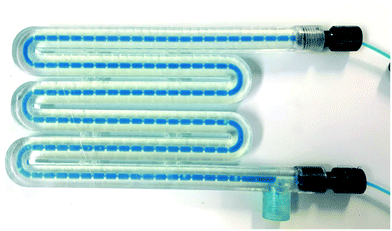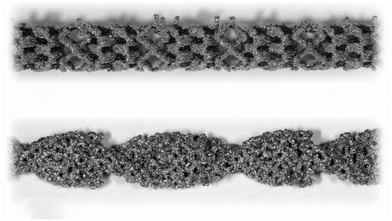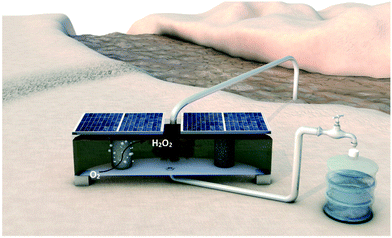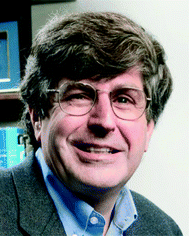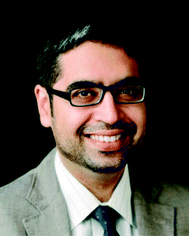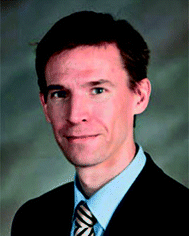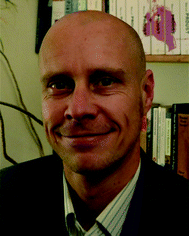Reaction Chemistry & Engineering Emerging Investigators 2017
Abstract
Reaction Chemistry and Engineering (RCE) as a journal was established with a vision to draw together the highest quality research, perspectives and reviews spanning the subjects of chemistry and chemical engineering specifically viewed with an interdisciplinary outlook.
This issue is focused on the work of early career researchers allowing us to recognise, showcase and celebrate the exciting work and achievements of a broad range of scientists performing pioneering research at the interface of these disciplines. The specific selection of individuals for inclusion within this special collection was achieved through invitation based upon the recommendation of senior scientists from both industry and academia. Our aim was to identify leading researchers from across the fields that were group leaders at an early stage of their careers and were conducting world recognised leading research.
Richard Bourne (University of Leeds, UK & RCE Advisory Board member)1 is a chemist working in the areas of continuous processing – including flow chemistry, sustainable chemistry, automation & optimisation and industrial process development. In his communication (DOI: 10.1039/C6RE00109B) he highlights how kinetic models can be generated for complex multi-step transformations using data rapidly captured from a series of flow experiments in a fully automated approach.
Timothy Noël (Eindhoven University of Technology, Netherlands)2 started with an industrial chemical engineering background which propelled him to move more into the area of chemistry. He currently works at the interface of these disciplines, specializing in C–H activation chemistry and flow photochemistry. His publication (DOI: 10.1039/C7RE00024C) highlights his practical and realistic approach to flow chemistry by identifying the limitations inherent to devising scalable flow photochemistry.
Laura Torrente-Murciano (University of Cambridge, UK)3 is a chemical engineer, whose research group focuses on the development of innovative integrated processes, using a combination of reaction engineering and advanced separation concepts, as well as on the development of novel nanostructured catalytic materials. Her submission to this issue (DOI: 10.1039/C6RE00202A), highlighted on the issue cover, demonstrates robust and tunable flow synthesis of silver nanoparticles in novel helical microfluidic reactor designs, and leverages an understanding of the fluid mechanics in the reactor to precisely control nanoparticle nucleation and growth processes (Fig. 1).
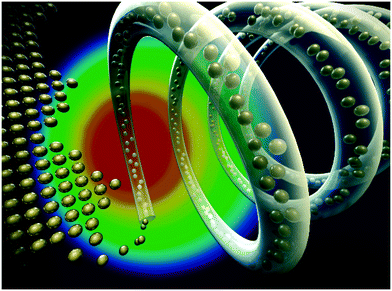 | ||
| Fig. 1 Front cover art depicting nanoparticle synthesis in the helix reactor reported by Laura Torrente-Murciano. | ||
Victor Sans (University of Nottingham, UK)4 has expertise spanning both sustainable chemistry and chemical engineering; his research group lies at the interface between these disciplines, and combines advanced reactor development using techniques like additive manufacturing with an interest in hierarchically structured advanced materials, for applications in catalysis and chemical sensing, among others. His contribution to this issue (DOI: 10.1039/C6RE00210B), featured on the issue cover, highlights the application of 3D printing methods in realizing novel configurations; specifically, a miniaturized version of the continuous oscillatory baffled reactor is used to realize the controlled synthesis of silver nanoparticles (Fig. 2).
Simon Kuhn (KU Leuven, Belgium)5 is a chemical engineer, whose research interests include multiphase fluid mechanics and transport processes in intensified reactor systems. His research group uses a combination of experimental and theoretical approaches to elucidate hydrodynamics and mass transfer processes in novel reactor configurations, which is exemplified in his submission to this special issue (DOI: 10.1039/C6RE00185H), featured on the issue back cover. Here, his research team reports detailed experimental characterization of the mass transfer performance of porous milli-scale reactors, demonstrating how intensified mass transfer can be accompanied by significant reduction in frictional energy dissipation in such systems when compared to conventional packed bed reactors.
Jean-Christophe Monbaliu (University of Liège, Belgium)6 is a well-travelled chemist whose research interests cover a wide range of topics involving the development of new synthesis methods (homogeneous and supported organocatalysts, selective copper-based oxidations and the processing of hazardous/unstable/transient species in microreactors) enhanced through the application of enabling technologies such as continuous flow reactors. His paper (DOI: 10.1039/C6RE00184J), which is highlighted on the issue back cover, succinctly summarises his strong synthetic background and interest in flow processing by describing the diastereoselective assembly of the active pharmaceutical ingredient methylphenidate (Ritalin) hydrochloride.
Yingwu Luo (Zhejiang University, China)7 works in the area of materials and polymer chemistry. His research is heavily focused on macromolecular engineering of nanostructured polymeric materials with applications as thermal elastomeric polymers, smart functional polymers and selective porous polymeric materials. He specialises in polymer assembly through living radical (mini)emulsion polymerization which is highlighted in this paper (DOI: 10.1039/C6RE00168H) using the RAFT technique to prepare specifically tailored styrene polymers based upon reaction modelling.
Rajamani Gounder (Purdue University, USA & RCE Advisory Board member)8 is trained as a chemist and chemical engineer, and leads a research group with an integrative focus on the science of heterogeneous catalysis. The problems studied by his group range from the catalytic conversion of carbon feedstocks from a variety of sources to pollution abatement. His contribution to this issue (DOI: 10.1039/C6RE00198J) highlights the latter, and connects zeolite topology to observed structural and kinetic changes during selective catalytic reduction (SCR) of NOx with ammonia.
Christian Hornung (CSIRO, Australia)9 is a senior research scientist and chemical engineer whose training spans organic and polymer chemistry, as well as microreactor engineering. His submission to this issue (DOI: 10.1039/C6RE00188B) further highlights the rising interest and excitement in additive manufacturing of novel reactors, and uses a combination of 3D metal printing of static mixers that are then coated with metal catalysts, for application in continuous flow hydrogenations (Fig. 3).
Ryan Hartman (New York University, USA & RCE Advisory Board member)10 is a chemical engineer, whose research programme revolves around multi-scale analysis, using both detailed experiments and predictive modeling, of flow chemistry within microfluidic systems. His research group has made contributions in diverse areas within this theme, from fundamental studies of interfacial fluid mechanics to flow chemistry in packed beds. In his contribution to this special issue (DOI: 10.1039/C6RE00177G), his group demonstrates the use of in situ Raman spectroscopy for the study of interfacial concentration and density profiles in immiscible non-polar/aqueous systems in a specially designed microfluidic device, for eventual application in the engineering of multiphase flow reactors under mixed reaction-mass transfer control.
Paul Dauenhauer (University of Minnesota, USA & RCE Advisory Board member)11 was trained as a chemical engineer; his current research addresses the challenges presented by catalysis, reaction separations and more widely the understanding of processes through modelling and reaction engineering (transport and fluid mechanics). These themes are applied towards his work on renewable (biomass derived) carbonaceous feed stocks and their application to the manufacture of new fuel sources and the generation of alternative bulk chemical streams. His submission to this issue (DOI: 10.1039/C6RE00176A) details the pyrolysis of lignocellulosic biomass and α-cyclodextrin as a replacement model within a thin-film reactor which by identification of product formation and an extensive kinetic analysis allows certain predictions about the sequence of degradation steps to be made (Fig. 4).
 | ||
| Fig. 4 Paul Dauenhauer's scheme of cellulose glycosidic bond cleavage near the reactive melting point TRM. | ||
Jinlong Gong (Tianjin University, China)12 has been primarily educated as a chemical engineer; his current independent research can be broadly classified into two parallel streams relating to aspects of energy generation (hydrogen production via steam reforming and fuel generation by photocatalytic reduction of CO2) and industrial catalysis. Both avenues of research require a strong mechanistic understanding of kinetics and surface phenomena (interfacial & surface catalysis) which is supported in his research by in-house computational chemistry and modelling. As part of his investigations into industrially useful transformation he has been actively examining the dehydrogenation reactions of alkanes to alkenes and the selective oxidation of alcohols over solid acid catalysts. The former is exemplified by his submission for this issue (DOI: 10.1039/C6RE00179C) describing the use of a ZnFe2O4 catalyst for the formation of 1-butene (Fig. 5).
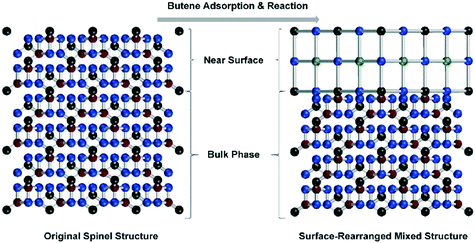 | ||
| Fig. 5 ZnFe2O4 crystal structure changes resulting from high temperature during the oxidative dehydrogenation of 1-butene, adapted from work by Jinlong Gong. | ||
Jason Hein (University of British Columbia, Canada)13 started in the area of biochemistry before moving to his advanced studies in organic synthesis. He has established his current research in the development of reaction analytical techniques (reaction progress analysis – process analytical techniques) as applied to furthering the mechanistic understanding of organic chemistry. He has particular interests in catalyst induction and deactivation as well as continuous preferential crystallization for the resolution of chiral compounds. Jason's publication (DOI: 10.1039/C6RE00211K) draws together several of these aspects to study the automated reaction monitoring of aldol reactions in terms of their enantio- and diastereoselectivity thus permitting through robust sampling of both solutions and slurries informative kinetic analysis.
Kai Wang (Tsinghua University, China)14 is trained as a chemical engineer, and has worked extensively on multiphase microfluidic systems, on both fluid mechanics and continuous flow chemical and materials synthesis. In his paper (DOI: 10.1039/C6RE00191B), his group investigates a problem of relevance to industrial carbon capture processes – dynamic interfacial tension changes in the reactive absorption of CO2 in aqueous amine mixtures; the results shed light on physical phenomena that affect mass transfer rates in these multiphase reactive systems, and inform process design.
Thomas Jaramillo (Stanford University, USA)15 is a chemical engineer with research interests that revolve around the relationship between energy and chemical transformations. His work focuses on investigations into fundamental catalytic processes occurring on solid surfaces in both the production and consumption of energy; chemical-to-electrical and electrical-to-chemical energy conversion. His publication for the issue (DOI: 10.1039/C6RE00195E) details the group's efforts in the development of a modular flow reactor for the electrochemical generation of H2O2 from using a mesoporous carbon cathode and a NiFeOx water oxidant at the anode. This would enable H2O2 production on site for either water remediation or chemical reaction (Fig. 6).
It is always a pleasure and an inspiration to be able to highlight the talents and inventiveness of some of the world's most promising young and emerging researchers and therefore we hope you will enjoy reading their contributions as much as we did.
Massachusetts Institute of Technology, USA.
National University of Singapore, Singapore.
Durham University, UK.
Royal Society of Chemistry.
References
- http://www.chem.leeds.ac.uk/People/Bourne.html .
- http://www.noelresearchgroup.com/timothy-noel/ .
- http://www.ceb.cam.ac.uk/directory/laura-torrente-murciano .
- http://sansresearchgroup.wixsite.com/home .
- https://cit.kuleuven.be/process/simon_kuhn .
- http://www.citos.ulg.ac.be/ .
- http://sklpre.zju.edu.cn/ktxzen/redir.php?catalog_id=16806&object_id=17170 .
- https://sites.google.com/site/rgounder/ .
- https://research.csiro.au/floworks/ .
- http://engineering.nyu.edu/flowlab/ .
- http://dauenhauer.cems.umn.edu/ .
- http://gonglab.tju.edu.cn/ .
- http://hein.chem.ubc.ca/ .
- http://www.chemeng.tsinghua.edu.cn/scholars/wangkai/WangKai.htm .
- http://jaramillogroup.stanford.edu/ .
| This journal is © The Royal Society of Chemistry 2017 |

